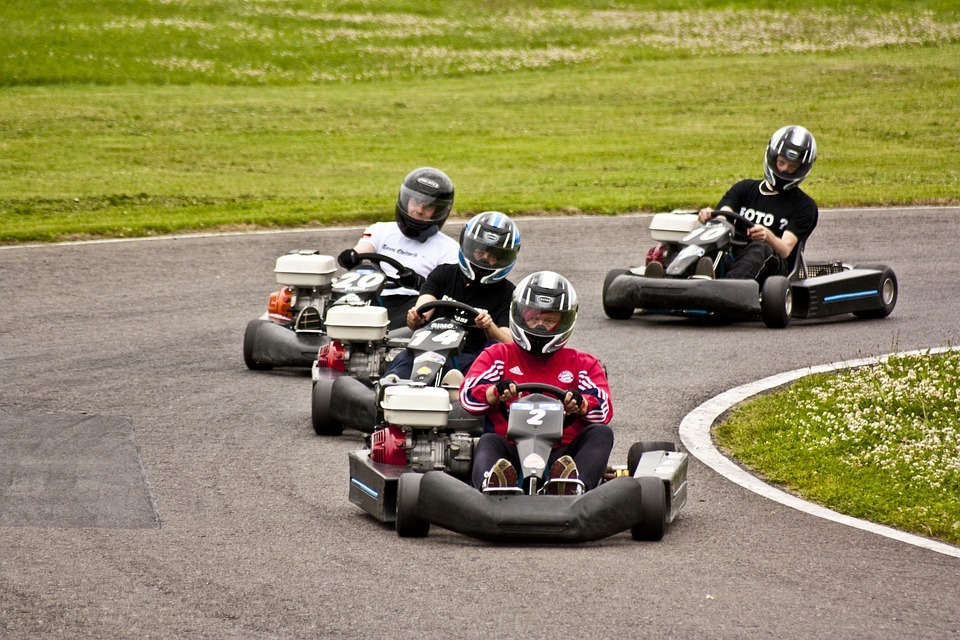Kart racing or karting is a type of motorsport racing that involves using open, four-wheeled vehicles known as karts or go-karts. It is a recreational activity that is pretty popular among motorsports enthusiasts. Karting is also done competitively. Usually, kart races are held on scaled-down circuits, although professional races hold full-size motorsport circuits. Motorsport is usually a stepping stone before going into higher ranks of motorsports. Karting first emerged in the United States is now also popular in Europe. Former Formula One champions like Ayrton Senna, Fernando Alonso, Lewis Hamilton, Michael Schumacher, Nico Rosberg, and Sebastian Vettel have started their careers in karting.
Go-karts vary in speed. Superkarts can reach speeds that exceed 161 kilometers per hour. Meanwhile, recreational go-karts made for the general public use could be restricted to lower speeds.
HISTORY
Art Ingels, an American, is generally credited as the father of karting. He is a veteran at hot rodding and is a race car builder for Kurtis Kraft. In 1956, Mr. Ingels built the first kart in Southern California. Karting had instant popularity, which quickly spread to other countries and currently has a massive following in Europe.
An American company, Go Kart Manufacturing Co., manufactured the first kart in 1957. The McCulloch company (1959) was the first to produce the engines for karts. The company’s first engine was a modified chainsaw two-stroke engine called the McCulloch MC-10. Later on, in the 60s, motorcycle engines were modified for kart use as well. These are before dedicated manufacturers started building engines specifically for motorsport.
COMPONENTS
Chassis
The vehicle’s base, or what’s known as the chassis, is made of chrome-moly tubing. Left without suspension, the chassis needs to be flexible enough to act as the suspension itself and stiff enough to avoid breaking or giving way on a turn. In the US, there are four classifications for kart chassis: Caged, Offset, Open, and Straight.
Engines
Four-stroke engines or electric motors power amusement park go-karts, while small two-strokes or four-stroke engines are used for racing karts.
Transmission
The transmission’s first purpose is to provide the torque which moves the vehicle under a swiftness of road and load conditions. It can also be shifted in reverse to allow the vehicle to move backward. Lastly, it can be shifted to neutral, which helps start the engine and run it without turning the drive wheels.
Tires
The kart’s tires and wheels are a lot smaller than those of an average car. Their rims are made of aluminum, composite materials, or magnesium alloy. The tires can support cornering forces exceeding 2 g or 20 m/s². Although, this depends on the motor setup, engine, and chassis.
Data acquisition
Various data acquisition systems, just like in other motorsports, have been developed for kart racing. Systems like these allow drivers to monitor parameters like the RPM, best lap, timing of laps, cooling system and exhaust gas temperature, and more from a fixed display on the steering wheel.
RACING FORMATS
The three most common karting races formats are:
Sprint
This racing format is done on kart circuits with left and right turns that resemble small road courses. The track lengths range from 400 meters to over 1,600 meters.
There are rounds of short-duration races in this racing format, typically for just a small number of laps. This qualifies for a final, and with calculations from a variety of point-scoring, an overall winner is determined. The race duration normally doesn’t exceed 15 minutes. In a sprint, speed and the ability to successfully pass are the most important. The format normally occurs in three qualifying heats and then the final race to determine the trophy positions.
Endurance
This racing format lasts for an extended period. The races range from 30 minutes up to 24 or more hours, for just one or more racers. For this format, reliability, consistency, and pit strategy are generally more important than the all-out speed.
Speedway
Speedway racing is done on asphalt or clay oval tracks. These are normally around one-tenth of a mile to one-fourth of a mile long. The tracks primarily include two straights and four left-turn corners. They also contain a few symmetrical tracks that are and often shaped like an egg or a tri-oval.
RACING CATEGORIES
There are a lot of different kart racing categories. One of those the grew the fastest in the US is Lo206. The general types are 50cc Kid Karting, 60cc Cadet Karting, 100cc tag, 125cc tag, 125cc Shifter, and 250cc Superkarts.
RACING LICENSES
As with all motorsports, driving a racing kart requires a license to race on a circuit or join competitions. They are provided by governing bodies and given by associations or clubs. The annual license fee usually includes basic insurance coverage. In other countries, the drivers are obliged to pass a medical exam each year according to the regulations.


